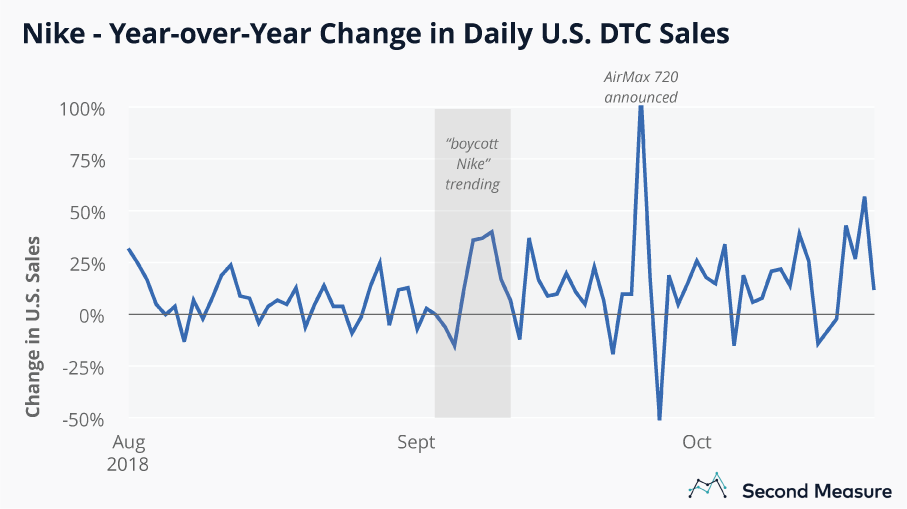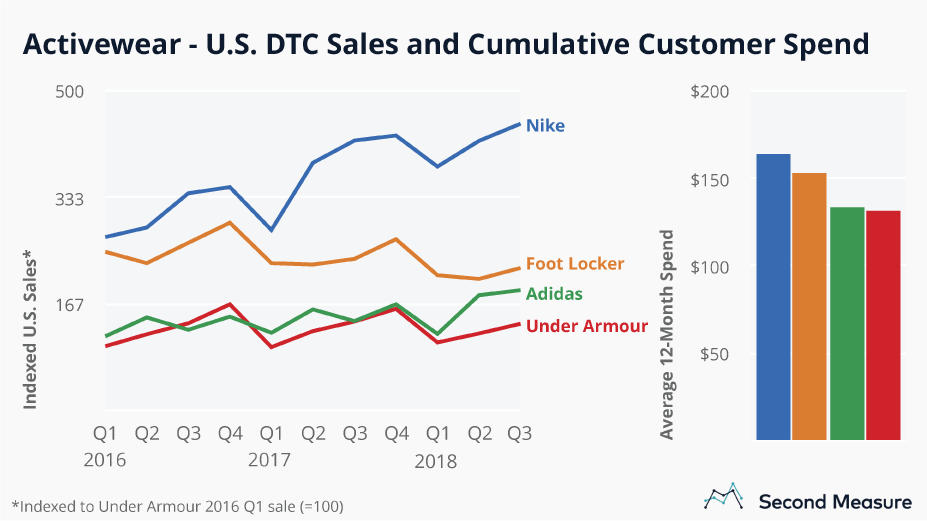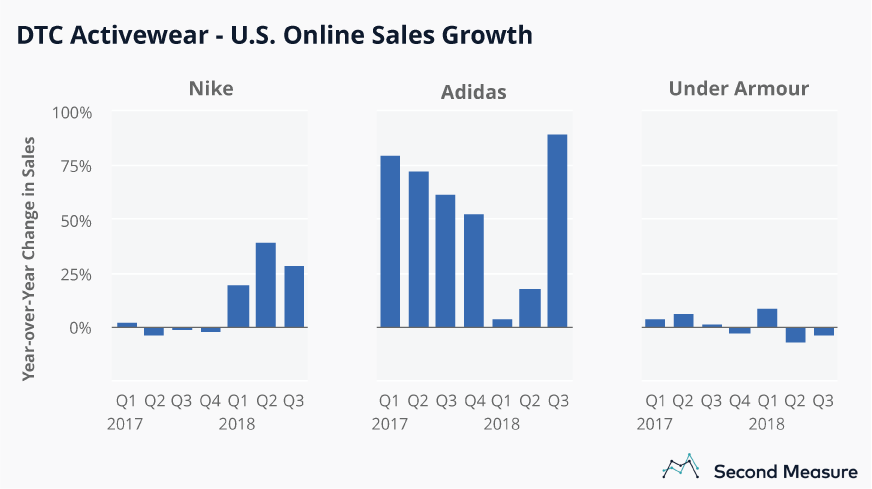NOTE: Bloomberg Second Measure launched a new and exclusive transaction dataset in July 2022. Our data continues to be broadly representative of U.S. consumers. As a result of this panel change, however, we recommend using only the latest posts in assessing metrics, and do not support referring to historical blog posts to infer period-over-period comparisons.
Americans are getting ready to cast their ballots in the midterm election but, thanks to Nike, they’ve already had a chance to vote with their wallets. After announcing its partnership with activist and former-NFL quarterback Colin Kaepernick, Nike received the overwhelming public response it no doubt intended—both positive and negative. The impact on Nike sales was short-lived, creating temporary noise within the more significant trend of Nike’s growing direct-to-consumer (DTC) business, which has increased in the U.S. by 15 percent year-to-date.
Nike sales show little impact from #BoycottNike
Nike’s ad campaign featuring Kaepernick was announced on Monday, September 3rd and sparked an immediate social media frenzy. Ads began running later that week, and Nike’s sales growth peaked the following weekend—the first of the NFL season—with spending across those two days up 38 percent over the same calendar weekend in 2017—also the first of football season.

Purchasing in support of Nike’s ads was offset by Kaepernick critics promising to boycott Nike and even going so far as to destroy their own Nike gear. The volatility petered out over the following week, leaving Nike’s September sales up by 7 percent year over year—nearly equivalent to its August growth. Though the ad campaign’s cultural significance should not be understated, the economic impact for Nike registered as a blip within the bigger story of a retail giant adapting to shifting trends of the digital age.
DTC sales have grown most for Nike
Nike has long been America’s dominant activewear brand. Air Jordans still carry major cachet with sneakerheads, even though it’s been fifteen years since their namesake retired from the NBA. His Royal Airness may be timeless, but the retail landscape is not. Nike has spent recent years building up its direct-to-consumer channel in an effort to stop handing away profits and valuable consumer data to the third-party sellers—like Foot Locker—that move its merchandise.
By raw dollars, Nike’s DTC business has increased more than competitors in 2018. Year to date, spending at Nike brands has increased by 15 percent year over year, not far off the growth of 17 percent seen by Adidas and its subsidiaries. Growth has been nearly flat for Under Armour, and sales are declining at Foot Locker. Spending at all four activewear retailers shows seasonality, with noticeable dips in the early months of the year.

Significantly, Nike also attracts the biggest spenders. On average, Nike shoppers spend 24 percent more than Adidas customers in the year of their first purchase. Bringing in high-value new customers to the DTC channel is a crucial component of growth. Spending history back to 2011 was used to identify new customers for this analysis.
Across the three DTC brands in 2018, roughly between a fifth and a third of monthly shoppers have been new customers. Despite already having the largest market penetration, Nike has also attracted the most new DTC customers year to date—over 50 percent more than Adidas and double Under Armour’s new shoppers.
Adidas has an online edge
While Nike continues to dominate the U.S. DTC activewear market, Adidas is making a strong online push, even going so far as to close retail stores in favor of its digital strategy. In 2017, Adidas grew its annual online sales by 63 percent, and by an additional 38 percent in 2018 so far. Nike has clearly stepped up its 2018 digital efforts, increasing its online sales by 29 percent year to date. As of last quarter, online sales represent approximately a third of U.S. DTC business at both Adidas and Nike, compared against a quarter at Under Armour.

Recent reporting shows the American market—DTC, online, and otherwise—now represents just 40 percent of Nike’s global revenue. But the U.S. is home turf for the Oregon-based brand, which hasn’t taken Adidas’s online encroachment lightly. Earlier this year, Nike acquired Zodiac, a data-analytics firm that has undoubtedly contributed to advancing Nike’s digital strategy.
Get in touch to follow the Nike vs. Adidas rivalry through the holiday season.
Oh, and we’re hiring.
